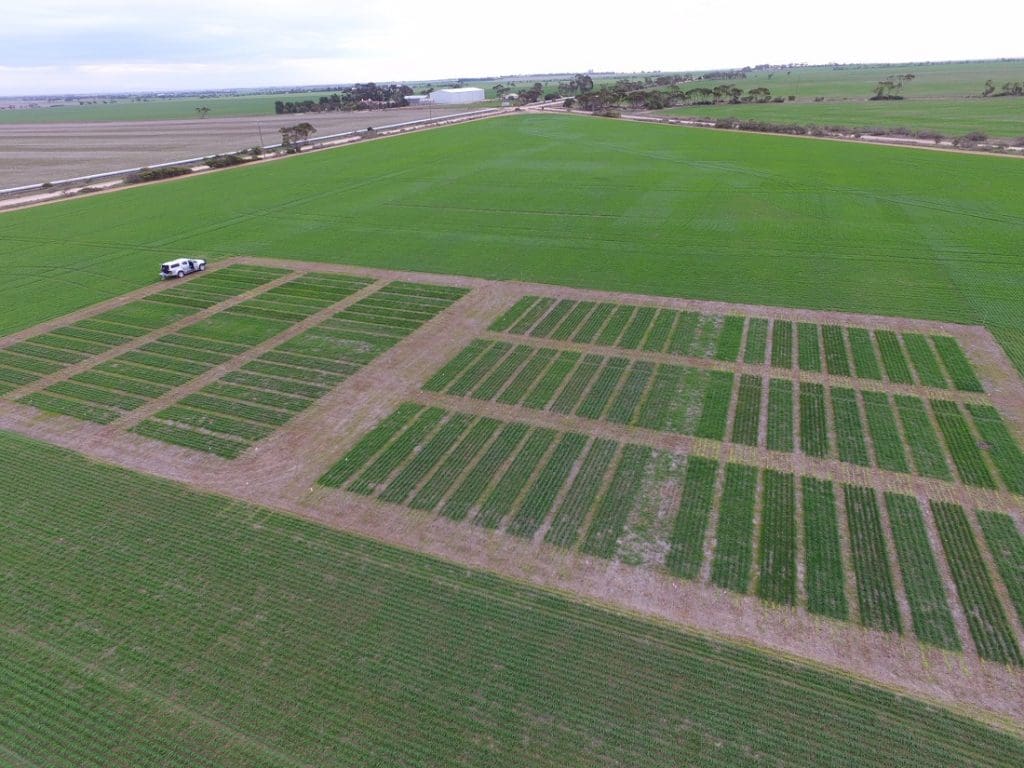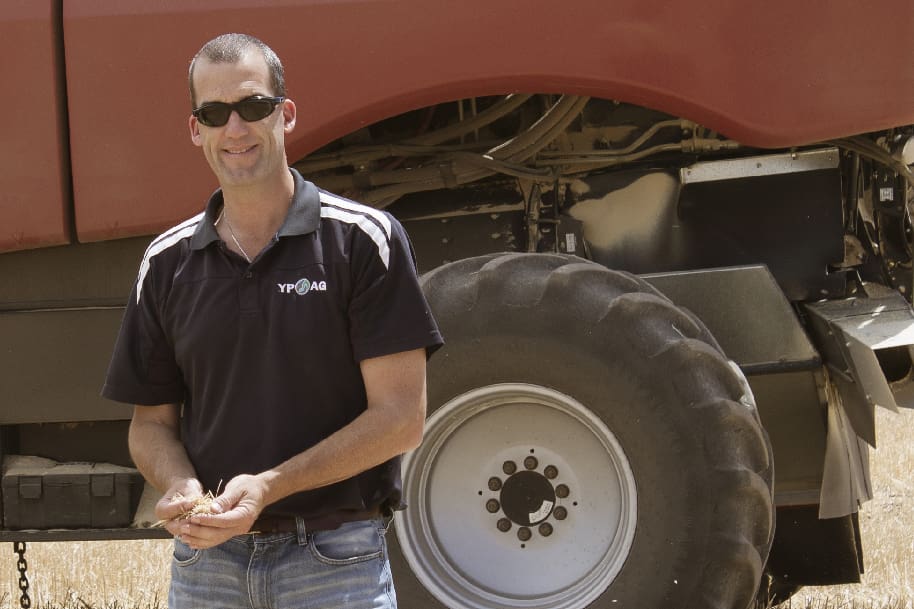
In the trial, the package of competitive crops and cultivars plus east-west sowing plus a premium pre-emergent herbicides mix combined to make an impressive difference in annual ryegrass numbers while also producing more grain.
Ask a WeedSmart Expert
OFTEN regarded as the ‘poor cousin’ to herbicides, crop competition is making a come-back as a simple way for growers to increase crop yield and reduce weed seed set, without breaking the bank.
YP AG partner and director, Chris Davey, Kadina, South Australia, has worked with growers on the Yorke Peninsula for over 20 years in an on-going battle with weeds such as annual ryegrass, brome grass and bifora, and mounting resistance to herbicide.

YP AG agriservices agronomist Chris Davey says several Yorke Peninsula growers have adopted east-west sowing after seeing the benefits of competitive crops combined with pre-emergent mixes in a recent trial.
“Working with our grower group we have demonstrated that stacking crop competition tactics at sowing really does make a difference,” he said.
“When you add an effective pre-emergent herbicide to the top of the stack to provide early weed suppression, the resulting increase in yield and reduction in weed pressure definitely puts money in the bank.”
In the 2018 trial, two cultivars of wheat (Scepter and Emu Rock) and barley (Compass and Spartacus) were sown into lentil stubble.
The trial compared the performance of these four cultivars when sown east-west v north-south, and with a range of pre-emergent herbicide packages.
“The result was clear – when you plant a competitive crop like barley in fertile soil – such as following lentils, row orientation doesn’t make much difference, but if you plant a poorly-competitive crop like wheat, it really pays to stack as many things in its favour, including east-west sowing and an effective pre-emergent herbicide,” Mr Davey said.
“In wheat we measured a consistent 0.5 tonne/hectare yield gain through east-west sowing across the two cultivars and pre-emergent herbicide packages. In barley, stacking a premium pre-emergent herbicide mix onto an already-competitive crop boosted yield by 1.1 t/ha and reduced ryegrass plant numbers ahead of the following seeding by over 80 per cent, compared to the least competitive, nil pre-emergent barley treatment.”
With harvest weed seed control already adopted by many growers on the Yorke Peninsula, the results of Mr Davey’s trial has prompted the adoption of even more WeedSmart Big 6 tactics to tackle herbicide resistance head-on.
What is the effect of crop competition on weed seed production?
Short answer: Crop competition makes a massive difference to weed seed production in-crop.
Longer answer: Ahead of this trial in 2018 the weed seed potential of the site was calculated as 87,000 annual ryegrass seeds/m2. The annual ryegrass population was known to be 100 per cent resistant to trifluralin (e.g. Treflan), 50 per cent resistant to triallate (e.g. Avadex) and 30 per cent resistant to prosulfocarb + s-metolachlor (Boxer Gold).
Applying crop competition plus pre-emergent herbicide drove this number down to around 4000 seeds/m2leading into the 2019 cropping season. The owner of the trial site chose to cut the surrounding crop for hay to prevent further blow-out of the annual ryegrass population. Although the crop competition plus pre-emergent herbicide package made a vast difference to weed seed production it is not a one-year fix for a ryegrass blow-out. It is important to keep the pressure on.
After seeing the results of the trial, several members of Mr Davey’s grower group immediately adopted east-west sowing on paddocks where the change was practical.
It is understood that it is often necessary to sow according to land type, such as on dune swale paddocks, or other constraints, such as established controlled traffic farming (CTF) systems that run north-south.
Where changing row orientation to east-west is not possible there are still many other ways to boost crop competition.
Where did the reduction in weed seed production come from?
Short answer: Stacking competition tactics and pre-emergents in barley reduced ryegrass weed seed set by over 80pc.
Longer answer: Changing from a less competitive (Spartacus) to more competitive (Compass) cultivar reduced ryegrass plant numbers at seeding in 2019 by 13pc on north-south orientation and 24pc on east-west orientation, with no pre-emergent applied.
Keeping the cultivar the same and changing row direction reduced weed numbers by 26pc in Compass and 16pc in Spartacus.
This suggests that changing to east-west sowing will not achieve much in barley unless a more competitive cultivar is chosen.
Changing both the competitiveness of the cultivar and the row orientation achieved a very useful reduction in weed numbers of 34pc (without using any pre-emergent).
The result may be even greater in a more common rotation where barley is planted after wheat and the initial soil nutrient status is less than after lentils.
When you add a standard pre-emergent mix (trifluralin plus triallate) to the east-west sown Compass, weed numbers are driven down by 50pc.
Using a premium mix of (Boxer Gold plus triallate) achieved an 82pc reduction in annual ryegrass plants going into the 2019 season.
This is particularly impressive given the field’s known resistance to the applied pre-emergent chemistry and highlights the value of stacking pre-emergents together and growing a competitive crop.
What impact did the treatments have on yield?
Short answer: East-west sowing increased wheat yield in this trial, probably due to extra competition at a very weedy site.
Longer answer: In wheat there was a consistent 0.5t/ha yield gain through east-west sowing across the two cultivars and pre-emergent herbicide packages. In barley, stacking a premium pre-emergent herbicide mix onto an already-competitive crop boosted yield by 1.1t/ha compared to the nil pre-emergent, north-south treatment.
Why worry about crop competition if there are new pre-emergent herbicides coming to market?
Short answer: The new herbicides will provide another useful tool for growers but are not the answer on their own.
Longer answer: The choice of pre-emergent herbicide should be the final decision after you have stacked as many crop competition tactics as possible.
Look for the most competitive combination of crop species/cultivar, row spacing, seeding rate, row orientation, sowing time for early vigour and healthy soil, then add a pre-emergent that is known to be effective.
If the crop competition is strong then the pre-emergent just needs to provide the early weed suppression that gives the crop a head start.
Strong competition plus a current premium pre-emergent package (Boxer Gold plus triallate) performed as well as the ‘experimental’ pre-emergent products in this trial.
Source: WeedSmart
………………………………………………………………………………………………………………………………………………….
How to ask a WeedSmart question
Ask your questions about on the WeedSmart Innovations Facebook page WeedSmartAU, Twitter @WeedSmartAU or the WeedSmart website www.weedsmart.org.au/category/ask-an-expert/
‘WeedSmart’ is an industry-led initiative that aims to enhance on-farm practices and promote the long term, sustainable use of herbicides in Australian agriculture.



HAVE YOUR SAY